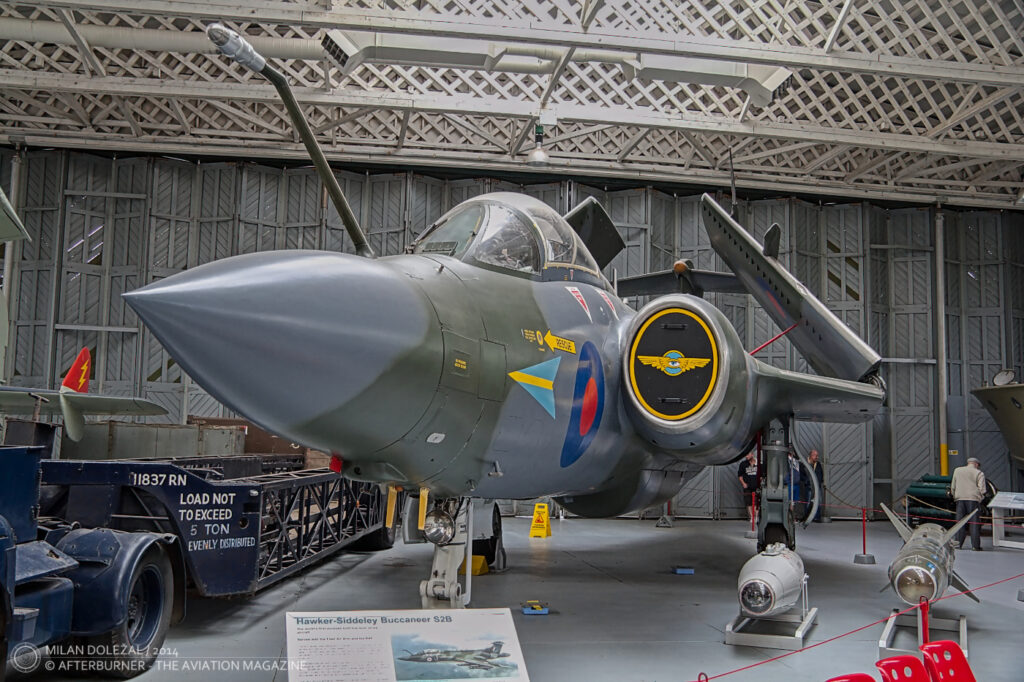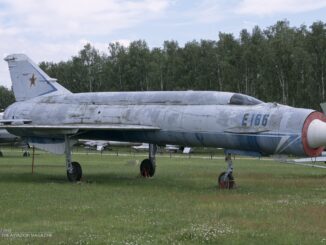 Hawker Siddeley Buccaneer S.2B (c/n B3-14-67, formerly XV865 of the Royal Navy), on display at Imperial War Museum Duxford, June 2014.
Hawker Siddeley Buccaneer S.2B (c/n B3-14-67, formerly XV865 of the Royal Navy), on display at Imperial War Museum Duxford, June 2014.
In June of 1952, the British Admiralty issued specification of a new naval aircraft, designated Naval Staff Requirement NA.39. The document called for a two-seat jet with folding wings and capability to perform high speed and low level attacks on enemy ships, with use of both conventional and nuclear weapons.
The specification included some basic characteristics required for the new attack aircraft. It had to be capable of flying at 550 knots (1,020 kph) at sea level, had a combat radius of 400 – 800 nautical miles, depending on the altitude, and had carry 3,600 kg of weapon load. The armament of the aeroplane had to include the Red Beard tactical nuclear bomb and the Green Cheese radar-guided anti-ship missile. In August of the same year, the Ministry of Supply issued a detailed request for that naval aircraft, designated M.148T, and based on the aforementioned specification.
That request was responded by three aviation manufacturers: Armstrong Whitworth (AW.168), Blackburn (Project B-103) and Short (PD.13). Evaluation of those proposals lasted from February of 1953 until July of 1955, when the Blackburn company was announced winner of the tender.
According to authors of the Buccaneer monographies, such as Roger Chesneau or Robert Jackson, the aforementioned request for the new attack aircraft was caused by launch of the Soviet Sverdlov-class cruisers (Крейсера проекта 68-бис – Project 68bis). The first cruiser of the class, Sverdlov (Свердлов), was laid down in October of 1949 and the Soviet authorities initially planned to build up to thirty examples.
The Sverdlov-class was a line of high-speed cruisers, equipped with modern radar suite and heavy anti-aircraft artillery. Although they were only a conventional-gun warships, the new Soviet cruisers created a significant threat to the British merchant navy. Therefore, instead of building its own cruiser class to outweigh the Soviet ships, the Admiralty decided to develop a dedicated attack aircraft that could address the threat.
Development of the new naval attack aircraft took place in secrecy. The aeroplane received a few code names, one of which was BANA (Blackburn Advanced Naval Aircraft). It quickly created an additional, but informal nickname, ´Banana jet´ (according to aforementioned authors).
The new naval aircraft performed its maiden flight on 30th April 1958 and was officially designated the Buccaneer. Within the next two years, the Blackburn company was taken over by Hawker Siddeley group. Although Blackburn was a separate division within the group, its aircraft were now marketed under the Hawker Siddeley name. The brand Blackburn finally vanished in 1963.
The Buccaneer was made as mid-wing, tandem-seat aeroplane. It was developed with use of the transonic area rule procedure, to reduce aerodynamic drag at high speed. In addition, the airframe of the Buccaneer was especially tailored for specific stress occurring at low-level operations – usual attack procedure required flying at the speed of 500 knots and as low as 100 feet (approx. 30 metres) above the sea level, to avoid detection by enemy radar.
The initial variant, known as S.1, was powered by two de Havilland Gyron Junior 101 turbojet engines. It shortly turned out that the Buccaneer was underpowered and the aforementioned powerplants were replaced by two Rolls-Royce Spey Mk 101 engines. The upgraded aircraft was designated S.2.
The first aeroplanes were delivered to the Fleet Air Arm in July of 1962. In January of the next year, the Buccaneer S.1 officially entered operational service. However, only a few aircraft were delivered in that initial variant, quickly being succeeded by the S.2. Until the end of 1966, the FAA converted all its Buccaneers into the Rolls-Royce-powered version.
The Buccaneer was a basic British naval low-level strike aircraft until the end of the 1970s. A total of six FAA squadrons were equipped with this type of aeroplane and the Buccaneers were based on board of HMS Victorious, HMS Eagle, HMS Ark Royal and HMS Hermes aircraft carriers.
In the 1970s, as a result of restructuration of the British armed forces, more than sixty of the FAA´s Buccaneers were transferred to the Royal Air Force. They took part in Operation Pulsator in Lebanon (1983) and in the Gulf War (1991). The RAF Buccaneers were withdrawn from service by the early 1994.
The only export customer for the Buccaneer was South Africa. In 1963, the country purchased sixteen aircraft, in special variant designated S.50. The South African Air Force operated the Buccaneers until 1991 and the aeroplanes saw combat in the South African Border War, during operations in Namibia and Angola.
The aeroplane VX865 was manufactured in 1968, as the Buccaneer S.2. In 1973, the aircraft was first upgraded to S.2D variant, capable of carrying Martel anti-radar missiles. After its withdrawal from the active service with the Royal Navy in 1978, the aircraft was transferred to the RAF and then modified to S.2B ground-based standard.
In 1994, the VX865 was retired from operational service. Five years later, the aeroplane was acquired by the Imperial War Museum and put on display in one of its hangars in Duxford.



